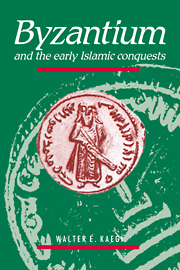Book contents
- Front Matter
- CONTENTS
- List of illustrations
- Preface
- List of abbreviations
- Chapter 1 The problem of Byzantium and the early Islamic conquests
- Chapter 2 The Byzantine Empire in an era of accelerating change
- Chapter 3 Difficulties in devising defenses for Syria
- Chapter 4 The first Muslim penetrations of Byzantine territory
- Chapter 5 Early tests in southern Palestine
- Chapter 6 Problems of cohesion: the battle of Jābiya- Yarmūk reconsidered
- Chapter 7 The brief struggle to save northern Syria and Byzantine Mesopotamia
- Chapter 8 Byzantium, Armenia, Armenians, and early Islamic conquests
- Chapter 9 Controversy and confidence in the seventh-century crisis
- Appendix 1 Author and date of the anti-jewish treatise
- Chapter 10 Elements of failure and endurance
- Bibliography
- Index
Chapter 3 - Difficulties in devising defenses for Syria
Published online by Cambridge University Press: 22 September 2009
- Front Matter
- CONTENTS
- List of illustrations
- Preface
- List of abbreviations
- Chapter 1 The problem of Byzantium and the early Islamic conquests
- Chapter 2 The Byzantine Empire in an era of accelerating change
- Chapter 3 Difficulties in devising defenses for Syria
- Chapter 4 The first Muslim penetrations of Byzantine territory
- Chapter 5 Early tests in southern Palestine
- Chapter 6 Problems of cohesion: the battle of Jābiya- Yarmūk reconsidered
- Chapter 7 The brief struggle to save northern Syria and Byzantine Mesopotamia
- Chapter 8 Byzantium, Armenia, Armenians, and early Islamic conquests
- Chapter 9 Controversy and confidence in the seventh-century crisis
- Appendix 1 Author and date of the anti-jewish treatise
- Chapter 10 Elements of failure and endurance
- Bibliography
- Index
Summary
DISTURBING PRECEDENTS
“All the Romans, both officers and soldiers, were far from entertaining any thought of confronting the enemy or standing in the way of their passage, but manning their strongholds as each one could, they thought it sufficient to preserve them and save themselves.” So the historian Procopius of Caesarea described how Byzantine commanders and soldiers in Syria and upper Mesopotamia consciously avoided open resistance to the Persians during their invasion of 540 and instead sought the security of town walls. This Byzantine military conduct in the sixth century was similar to the actions, indeed prophetic of the actions, of Byzantine commanders and officers in the same region who faced Muslim invaders in the seventh century.
The topography of Syria itself varied from empty steppe in the east to the irrigated and populous Orontes valley and the equally populous Mediterranean coastline. Its dimensions stretched from the edge of the Sinai and Arabian peninsulas to the south, to the desert to the east, and to the Euphrates River and foothills of the Taurus to the northeast and northwest (Map 2). Byzantine Syria had experienced Persian invasions of terrifying dimensions in both the fourth and the sixth centuries.
Similar to local garrisons, a number of Syrian and upper Mesopotamian towns had negotiated with the Persians instead of resisting to the end.
- Type
- Chapter
- Information
- Byzantium and the Early Islamic Conquests , pp. 47 - 65Publisher: Cambridge University PressPrint publication year: 1992



